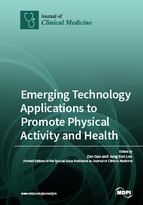Emerging Technology Applications to Promote Physical Activity and Health
A special issue of Journal of Clinical Medicine (ISSN 2077-0383). This special issue belongs to the section "Epidemiology & Public Health".
Deadline for manuscript submissions: closed (15 October 2018) | Viewed by 129302
Special Issue Editors
Interests: physical activity epidemiology; physical activity interventions; emerging technology applications; physical activity measurement
Special Issues, Collections and Topics in MDPI journals
Interests: psychological correlates of physical activity; technology-based physical activity promotion; motor skill enhancement
Special Issues, Collections and Topics in MDPI journals
Special Issue Information
Dear Colleagues,
As technology becomes an ever-more prevalent part of everyday life, and population-based physical activity programs seek new ways to increase lifelong engagement with physical activity, these two ideas have become increasingly linked. This Special Issue attempts to offer a thorough and critical examination of emerging technologies in physical activity and health promotion, considering technological interventions in different contexts (communities, clinics, schools, homes, etc.) among various populations, exploring the challenges of integrating technology into physical activity promotion, and offering solutions for its implementation. This Special Issue aims to occupy a broadly positive stance toward interactive technology initiatives and, while discussing some negative implications of an increased use of technology, offers practical recommendations for promoting physical activity through various emerging technologies, including, but not limited to: Active video games (exergaming); social media; mobile device apps; health wearables; mobile games, augmented reality games, global positioning and geographic information systems; and virtual reality. Offering a logical and clear critique of emerging technologies in physical activity and health promotion, this Special Issue will provide useful suggestions and practical implications for researchers, practitioners, and educators in the fields of public health, kinesiology, physical activity and health, and healthcare.
Prof. Dr. Zan Gao
Dr. Jung Eun Lee
Guest Editors
Manuscript Submission Information
Manuscripts should be submitted online at www.mdpi.com by registering and logging in to this website. Once you are registered, click here to go to the submission form. Manuscripts can be submitted until the deadline. All submissions that pass pre-check are peer-reviewed. Accepted papers will be published continuously in the journal (as soon as accepted) and will be listed together on the special issue website. Research articles, review articles as well as short communications are invited. For planned papers, a title and short abstract (about 100 words) can be sent to the Editorial Office for announcement on this website.
Submitted manuscripts should not have been published previously, nor be under consideration for publication elsewhere (except conference proceedings papers). All manuscripts are thoroughly refereed through a single-blind peer-review process. A guide for authors and other relevant information for submission of manuscripts is available on the Instructions for Authors page. Journal of Clinical Medicine is an international peer-reviewed open access semimonthly journal published by MDPI.
Please visit the Instructions for Authors page before submitting a manuscript. The Article Processing Charge (APC) for publication in this open access journal is 2600 CHF (Swiss Francs). Submitted papers should be well formatted and use good English. Authors may use MDPI's English editing service prior to publication or during author revisions.
Keywords
- active video games
- augmented reality games
- exergaming
- global positioning and geographic information systems
- health wearables
- mobile device apps
- physical activity and health promotion
- social media
- virtual reality








